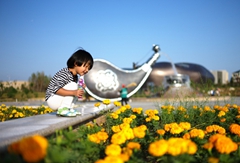In coal region, Ordos sets pace for green switch
Updated: 2021-11-24 (China Daily)  Print
Print 



Workers maintain photovoltaic panels in April in Ordos, Inner Mongolia autonomous region. The city, a major coal production center in China, is optimizing its energy structure by introducing more clean energy. [Photo provided to chinadaily.com.cn]
Ordos, Inner Mongolia autonomous region, wants to change its energy diet to something greener — gradually introducing renewable resources to help the country meet its goals for peak emissions and carbon-neutrality, local authorities said.
It's no easy challenge: The autonomous region's vast coal reserves, about 29 percent of the country's total, with Ordos representing about half of that, have been a sweet resource for decades, providing a steady supply of electrical power for development.
But success has come at the cost of high carbon emissions, and now the city is focusing on how to make the transition.
The good news is that Ordos is blessed with the means to make the switch, as is the region more generally. In addition to coal and natural gas resources, Inner Mongolia's broad deserts offer lots of wind and sun, suggesting new possibilities for gradually transforming its traditional reliance on fossil fuels to clean energy.
In October, the city released a plan for what it is said was the "world's first net-zero industrial park", in partnership with a green technology company, Envision Group. The vision is to become a hub of a new industrial revolution along the Yellow River, they said.
The plan is to open the park in the first half of next year, using a clean energy supply network composed of wind and photovoltaic power, as well as energy storage. When excess power is produced, 20 percent will be sold to the grid. And stored green energy will be retrieved from the grid when needed, ensuring a 100 percent net-zero energy supply, steady electricity and low prices, according to Zhang Lei, CEO of Envision Group.
Carbon emissions and energy consumption will be monitored in real time for optimal results, he said, adding that the park — which will mainly focus on electric vehicle batteries and the automobile industry — will provide useful experience for the transformation of other high energy-consuming cities and the development of net-zero industries globally.
The battery production base at the park, with a planned capacity of 20 gigawatt-hours, is expected to provide batteries for more than 30,000 heavy trucks, as well as electrical storage of 10GWhs.
Envision Group will cooperate with major automakers in Ordos to replace the city's 330,000 diesel trucks for coal transportation with electric ones, reducing 30 million metric tons of greenhouse gas emissions and cutting operating costs by 30 billion yuan ($4.7 billion). It will broaden the use of new-energy vehicles to environmental sanitation, logistics, public transportation and other sectors.
A hydrogen production program using green energy at the park will help decrease coal consumption in steel making and the chemical and biosynthesis industries in Ordos.
Hua Ruifeng, Party secretary of Ejin Horoo Banner of Ordos, where the park will be situated, said the park will help promote industrial transformation, optimize the energy structure and develop innovative technologies related to the net-zero goal.
"The park will not only drive our new energy industries and promote high-quality development of the economy but also support new development ideas for the country," he said.
For Envision Group's Zhang, the park is attractive for companies because it offers cost-effective, secure and 100 percent green power to meet both energy consumption and sustainable development demand. It gathers a complete industrial chain for automakers, including anode and cathode materials for batteries, battery diaphragms and electrolyte production.
Many high energy-consuming enterprises have signed agreements to build branches or factories in the park, including those in the battery, photovoltaic manufacturing, hydrogen production, commercial truck and materials sectors — including China's oldest and largest truck manufacturer FAW Jiefang, heavy truck company SAIC-IVECO Hongyan Commercial Vehicle Co and anode materials producer Guangdong Kaijin New Energy Technology.
Hu Hanjie, chairman of FAW Jiefang, said the company aims to sell 500,000 new-energy vehicles by 2035, representing 70 percent of its total sales. And the park can provide batteries for the company. Its clean energy will greatly cut the company's diesel transportation costs, he added.
Wang Guixuan, president of the industry division of German automotive and industrial supplier Schaeffler in China, said it's hard for the company to buy green power for its factories in southeastern Chinese regions, but the park will change that by providing direct access to power at the place where it is produced. Schaeffler expects to be using 100 percent green power by 2024, he said.
"The park gives everyone an idea that carbon dioxide shouldn't be emitted casually, and that it's everyone's duty to save Earth," he added.
Luo Yuefei, 40, a government worker in the Kangbashi district of Ordos, a major tourism area, said she can feel a rising awareness of low-carbon life in recent years.
"All buses in the district have begun to use electricity. There are many charging stations and electric motorbikes along the street," she said.
"If clean energy can be applied in more areas, such as garbage and transport trucks, as well as heating systems, the air quality will be better and the environment will be better protected. I think it means a lot that a major coal area is dedicating itself to promoting the country's low-carbon strategy."





 Ordos Impression
Ordos Impression Ordos WeChat
Ordos WeChat Ordos Reported
Ordos Reported


